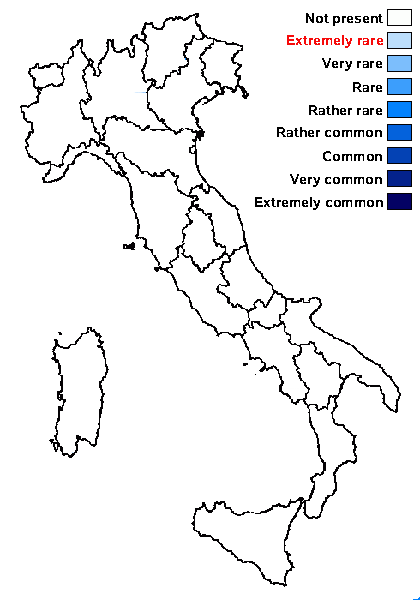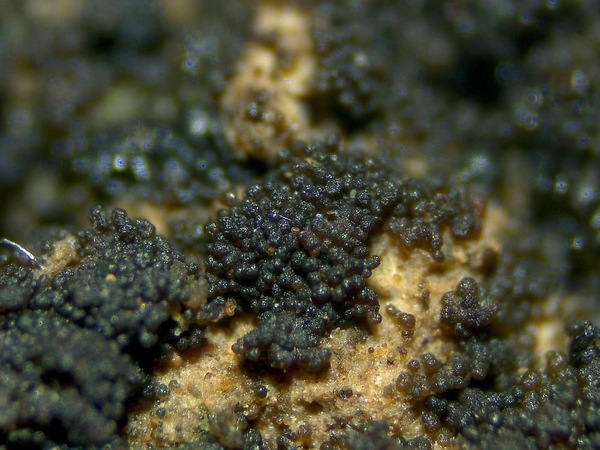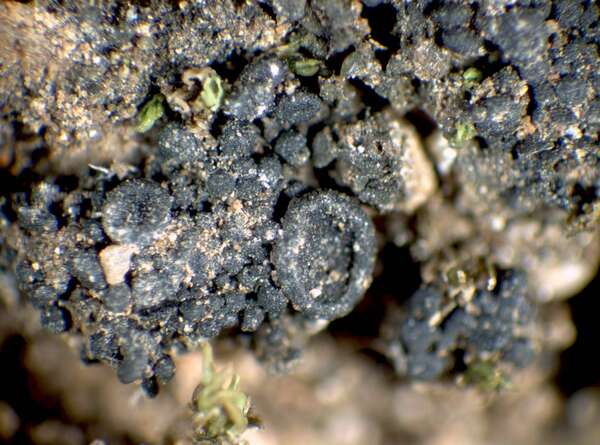Peccania fontqueriana P.P. Moreno & Egea
Acta Bot. Barcinon., 41: 37, 1992.
Synonyms:
Distribution:
Description: Thallus minutely fruticose, subgelatinous when wet, forming 1.5-3 mm wide and 1-2 mm tall, coralloid pillows, black when dry, dark olivaceous brown when wet, attached by a central bundle of rhizohyphae. Branches cylindrical, tapering at apex, erect, densely dichotomously branched, 0.1-0.13 mm thick, ecorticate, the peripheral part 20-35 μm thick, with a loose network of anticlinally oriented hyphae enclosing the photobiont, the inner part with an irregular, 50-60 μm thick axial strand made of 2-4 μm thick hyphae, most evident near the base. Apothecia terminal, 0.35-0.8 mm across, at first urceolate, then clearly lecanorine, with a concave to flat, black disc and a thick thalline margin. Proper exciple absent; epithecium yellowish brown, poorly differentiated; hymenium colourless, but with conspicuous brown to red-brown patches in the upper third, 50-75 μm high, I+ blue; paraphyses irregularly branched and anastomosing, 1-2 μm thick, not constricted at septa, not capitate; hypothecium yellowish brown, 40-60 μm high. Asci 8-spored, broadly clavate, thin-walled, with a distinct gelatinose, amyloid outer cap, but no apical dome, Peccania-type. Ascospores 1-celled, hyaline, broadly ellipsoid, 10-16 x 4-9 μm. Pycnidia immersed, ellipsoid, 100 x 40-60 μm. Conidia 1-celled, hyaline, thread-like, curved, 20-40 x c. 1 μm. Photobiont cyanobacterial, chroococcoid, with single or paired 6-14 x 6-12 μm large cells often penetrated by haustoria, surrounded by a yellowish brown gelatinous sheath which tends to become thinner and paler in internal parts. Spot test: all negative. Chemistry: without lichen substances. Note: a terricolous species of basic soils, often growing on other lichens, known from Algeria, Morocco, Macaronesia and SE Spain; to be looked for in Mediterranean Italy.
Growth form: Fruticose
Substrata: soil, terricolous mosses, and plant debris
Photobiont: cyanobacteria, coccaceous (e.g. Gloeocapsa)
Reproductive strategy: mainly sexual

Predictive model
Growth form: Fruticose
Substrata: soil, terricolous mosses, and plant debris
Photobiont: cyanobacteria, coccaceous (e.g. Gloeocapsa)
Reproductive strategy: mainly sexual

Predictive model
 Index Fungorum
Index Fungorum
 GBIF
GBIF





